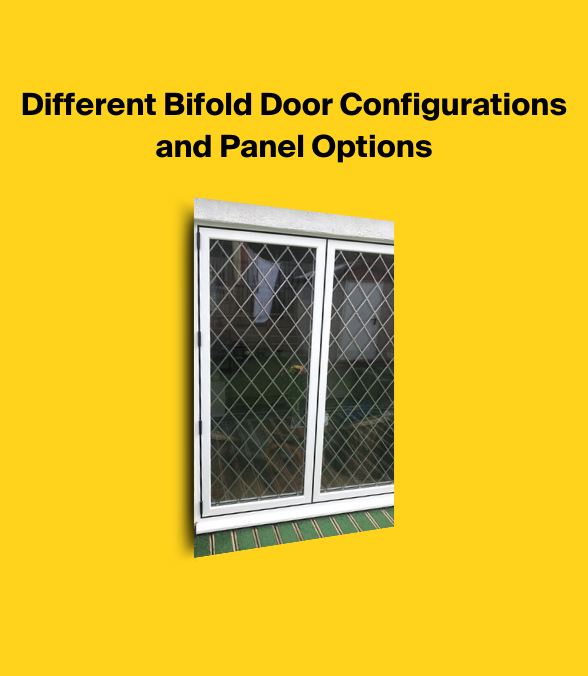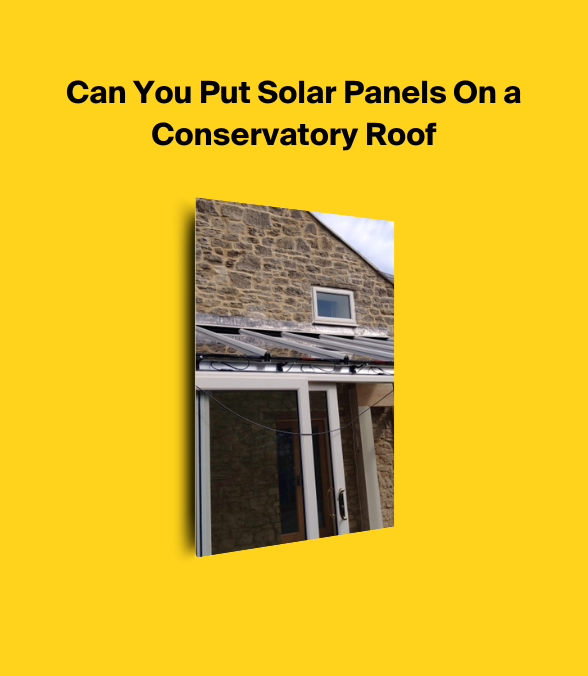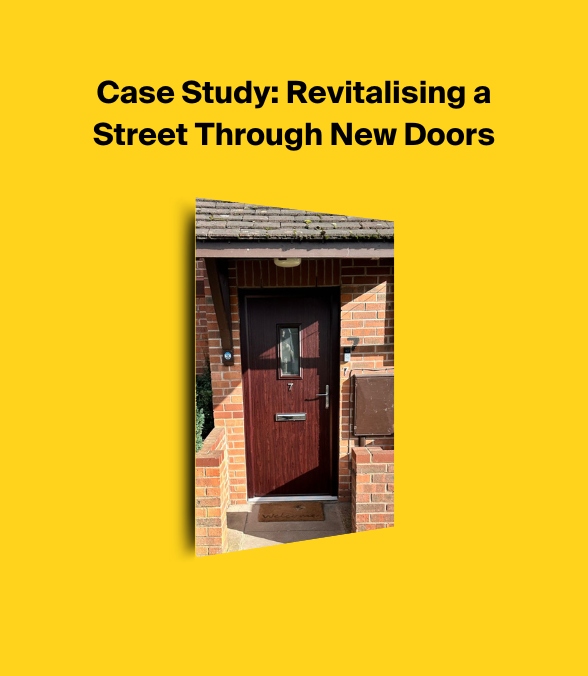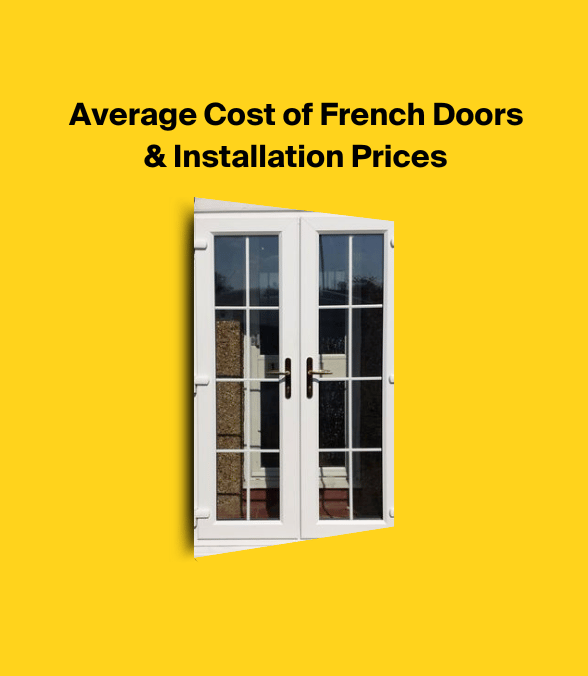Configuration & Panel Choices for Bifold Doors
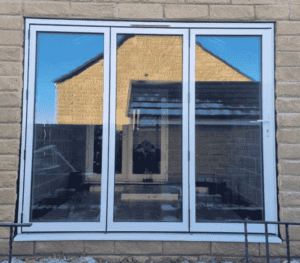
A bifold door makes a fantastic addition to any home, and they're making a strong comeback to modern houses all over the world.
Bifold doors are one of the most space-efficient entryways for your home.
They provide you extra floor space in confined areas like jammed bedrooms, compact kitchens, and more.
Bifold doors allow natural light to flow into your home with ease and will brighten your life, creating a more cheerful atmosphere to enjoy for years to come.
If you've been searching for a way to save space in your home and create a healthier environment, bifold doors are the way to go.
There are lots of types of bifold doors and they're simple to use, effective, and a pretty sight for sore eyes. A bifold door has two or more panels that are hinged at the ends so that as it opens, they may be folded easily and placed to one side in a sort of concertina effect.
When they are ready to shut, the panels slip out from the stack and start to flatten out once more, providing benefits that are both functional and visually pleasing.
You can design a door online now using our online configurator in minutes.
What Is A Bifolding Door Traffic Door?
Firstly, as mentioned below, let's find out what a traffic or access door is!
A traffic door resembles a regular door, but it is a component of your bifold door. You can open it without opening the entire door because it opens and locks fully independently from the rest of the system.
The idea is to make connecting your interior and exterior spaces simple and convenient whilst keeping the rest of your bifold doors secure. For bifold doors, they consist of a number of panels that swing open to provide simple access and operate independently.
Choosing The Best Bifolding Door Opening Options
There are many ways to customise your doors, depending on the design methods you'd like to use.
The larger the entrance, the larger the door. When designing your dream aluminium bifolding doors, it's always best to take the opening layout into account before you start.
These possibilities range based on your requirements, such as the number of leaves, the sliding direction of your doors, and the opening and closing mechanisms of your doors.
The number of door panels you may need for your new bifocal doors really depends on the size of the door openings, your overall budget, and a number of other factors.
Your new door's configuration will vary based on the bifold door size, and layout of your house. The range of opening options increases as you add more leaves (the part that slides open and closed).
Bifold Door Configurations, Sizes, And Options
The way you open a bifold door is mostly determined by the number of rooms you wish to open and the size of the opening that is available. Knowing your alternatives might help you make the best choice since these can be designed in a variety of ways.
Configuring your bifolding doors includes the process of assessing the size of the area, deciding how many panels your bifolding doors should have, the frames, traffic door options, colour and handles.
Different panel configurations have different effects and practical uses. Sizing up your bifolding doors is an important step of the process, and knowing the standard bifold door sizes will help you in the long run.
2 Panel Bifold Door Configurations
Smaller areas can benefit from a 2-door panel system, especially if the structural opening is small.
This design only allows for the panels to fold either left or right - creating a full opening - compared to a single leaf configuration that only exists behind a fixed panel. 2-panel bifolding doors are also a fantastic option when replacing traditional French doors.
4 Panel Bifold Door Configurations
Larger areas benefit greatly from 4-panel bifolds, and there are numerous options for changing the direction your panels slide. You have a number of movement possibilities for four-panel bifold door configurations:
- Every panel slides and folds to the right.
- Every panel slides and folds to the left.
- Three doors slide and can fold back, and one door serves as an access door.
- A French traffic door in the midst of two sliding panels on either side.
4 Panel Bi-Folding Door Set with 3+1 Door Configuration
There are three doors to the right and an open master door on the property. The master door swings open on hinges and latches onto a magnetic catch then glides open the remaining distance with the help of the handle.
6 Panel Bifold Door Configurations
6-panel doors, which have an additional two leaves compared to 4-panel doors, are used for substantially bigger rooms. When opening, 6-panel doors have four options:
- Doors all slide to the right.
- Doors all slide to the left.
- Three doors on one side and three on the other.
- A traffic or access door in the split-door configuration, either on one side or somewhere else.
6 Panel Corner Opening Bi-Folding Door Set – 3+3 Door Configuration
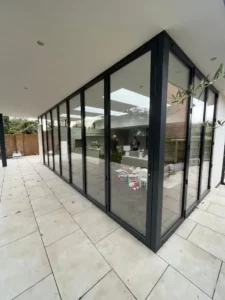
This is a great option for extended homes, with the traffic door in the middle and opening up the room to a lot of natural lights.
There is a 3-panel combination on one side that can open and slide to a closed position, followed by a 2-panel that follows the same sliding pattern.
Standard Length, Width, And Height
The precise dimensions will differ from one manufacturer to the next; the two minimum specifications to take into account are the width of one panel and the width of all the sets combined.
The standard dimensions are highly relevant, and the minimum width depends on whether you've picked an even or an odd arrangement.
The minimum width of one door leaf is 16 inches for odd-number combinations and 28 inches for even-number variants. If you choose to adjust the measurements, it can affect the efficiency of the sliding function of your doors.
3 Panel Bi-Folding Door Configuration
Three-panel bifold doors are among the most widely used bifold door configurations due to their affordability and adaptability.
A 3-panel folding door works nicely with the majority of houses. However, when you have a 3-panel bifolding door set, all the doors have an open door.
This design has the advantage of giving you three different opening possibilities:
- All doors slide to the right.
- All doors slide to the left.
- A traffic or access door between two sliding doors.
Bifold Door Materials
There are many different types of materials you can use to make your bifolding doors, depending on the environment, look, and feel you are hoping to achieve. Each different material boasts various advantages according to the desired atmosphere.
Wooden bifold doors
Using wood as your preferred material for your bifolding doors is a great choice if you seek a more natural aesthetic for your home.
There are several benefits, such as wooden bifold doors that can be stained, lacquered, or painted in practically any colour to fit both classic and contemporary designs.
When employing a wooden design, you'll also find that it is useful for sound absorption making it possible to create calmer spaces and muffle outside noise. Using wood for your bifolding doors is environmentally friendly and much better for the earth!
uPVC bifold doors
Unplasticized polyvinyl chloride is a sturdy, easy-to-look-after, yet lightweight plastic building material. It's incredibly budget-friendly as a result and only requires a simple wipe-down to maintain its fresh look.
uPVC bifold doors are good insulators and have many colour/pattern designs for you to choose from.
Aluminium bifold doors
In comparison to uPVC, aluminium has far better structural strength and can incorporate more glass into the design.
Aluminium is the most popular choice and is ideal for doors leading to your back garden or patio. It has a long lifespan, is easy to clean and remains low-maintenance as far as material goes, and can be recycled.
Opening Direction
The placement of the lead door, which opens first and has a multi-point locking mechanism, depends on the layout.
When choosing bifold doors, the direction of the opening and whether the bifold doors open in or out is an important factor that is frequently overlooked.
Depending on the direction, the door may slide entirely in one direction, such as to the right, or it may split in two and rest on both sides. When you open the sliding door to the right, it appears easy to open and compact.
If you were to use many bifold doors, it would also function nicely. If the configuration has two panels that slide left and three that slide right, with the lead door in the middle, the lead door will sit on either side once opening.
If there is limited space inside, you have the choice to fold your doors outside to save on room.
Threshold Options
When it comes to fitting bifold doors, ensuring your doors slide smoothly is so important for long use. Thresholds are the bottom track along which the wheels for the entire system, enabling the door panels to slide, open and close.
The threshold options at your disposal are:
- Standard threshold - The most common choice for your home is the standard threshold, it usually comes with a tiny upstand and offers insulation. They tend to lay lower and require the removal of bricks at the bottom of the base.
- Interior low threshold - These are generally used for bifolding doors on the interior of your home and thus offer minimal protection against weather elements.
- Ramp-type bifolding door thresholds - These are not as common. They provide accessibility for those who are disabled and are typically present in public areas.
Weathered Threshold
The gaskets and door seal tightly against a weathered (or rebated) threshold when a bifolding door is closed. This is due to the upstand.
These levels have a weathering grade and are trustworthy weather protections that successfully ward off the elements. The most common option is the standard threshold because it offers a weathered threshold.
On rare occasions, a bifold door may be misplaced, making the threshold less effective. If this does happen, you will have to adjust your bifold doors to make sure they are fit back into place and work as efficiently as they did before.
Colour Options
Depending on your material choice for your bifolding doors, they can be coloured and decorated according to your own personal aesthetic or the architecture of your home.
The colour of a wooden bifolding door changes according to the type of wood, eg: oak, cedar, white pine, hardware, etc. For aluminium and uPVC, these are generally available in standard white or silver flourishes, with options for matt and dual colours.
Popular Bifolding Door Handles
Your handle choice depends entirely on your personal preferences. The general options for handles are:
Stainless steel: these are durable, have a sleek finish, and are heat-resistant.
Aluminium: modern design for contemporary doors and practical for renovation.
Warmcore: these are considered a combination of aluminium and PVC; these handles are curved.
Final Thoughts
Bi folding doors have numerous attributes, purposes, and aesthetically appealing elements. Bifolding doors help to provide natural light and are growing in popularity since they add additional space to homes across the world.
The perfect design for you depends on your preferences - from straightforward ones like 1-panel configurations to more intricate ones like a 6-panel corner opening bi-folding door set with a 3+3 configuration.
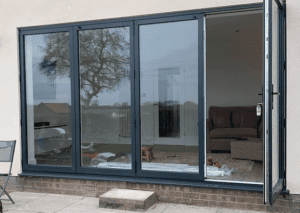
Bifolding doors offer versatile open-plan living spaces in a beautiful way.
You can use them to divide up two areas, such as a kitchen and a living room, and have the ability to quickly open them up when necessary.
Installing bifold doors goes above and beyond typical home improvement.
The increased natural light and fresh air, the seamless mixing of inside and outside space.
Even the possible increase in house value are all ways that bifold doors can significantly improve your quality of life.
Frequently Asked Questions
Do bifold doors need a lot of maintenance?
No, bifold doors require very little maintenance. In fact, they usually only need to cleaning and maintenance around once a year.
This makes bifolds one of the better options for a back door, as most bifold door problems can be fixed rather easily.
What are bifolding doors made of?
uPVC, timber, or composite may all be used to make bifolding doors depending on your tastes and surroundings. Aluminum is the material that is most used.
Can bifolding doors fold inwards and outwards?
Depending on your desire, bifold doors may be designed to open inwards or outwards. The panels will either reside within your house or open to your outside space when the doors are pulled back.

